Some plants can grow only in open ground, others are intended for room growing. Each varieties have certain requirements for planting and growth conditions that need to be performed. However, besides them there are flowers and decorative plants that can be grown without any problems in the garden or on the windowsill, or on the balcony. It is that such plants include Clematis - a beautiful decorative liana, which is one of the most popular plenty plants, widely used in the decoration of the site and to create vertical landscaping.
Clematis on the balcony or loggia is not at all a fairy tale and not the transcendental dream, everything is quite real, the main thing is serious to the process of landing and growing and you will get a small garden from Clematis, without leaving home.
In this article, consider the features of Clematis, we present the characteristics of the varieties of this plant for growing on the balcony, as well as we will understand more in more detail if Clematis can be raised on the balcony.
Botanical description and features of Clematis
Clematis is rustic or grassy perennial plants that can have a whip, herbaceous or plenty shape. Many gardeners call this plant with a flower capable of replacing the whole garden. Clematis belong to a large family of ilok. The natural area of \u200b\u200bthe habitat of this culture is the moderate and subtropical territories of the Northern Hemisphere, where wild clematics grow in undergrings and edges, forests and steppes, on the banks of the rivers and in the gorges. This plant has also popular names that are most often used - Lomonosa or Lozinka. There is an opinion that the plant called the Lomonosoma due to a sharp unpleasant smell of only dug roots or because of a small hooked outflow on the tubers.
The very first mention of Clematis cultivation refers to Japan, where this plant became interested long to other countries. On the territory of Western Europe, decorative lianas began to grow in the 16th century. It is from European countries that this plant appeared in Russia. This event relates to about the end of the 19th century. At first, Clematis were treated very wary, which is associated with the ignorance of the peculiarities of growing this plant and a small amount of varieties with excellent qualities. At the beginning of Clematis, they admired only in Orangers, and after some time these beauties-Liana moved to the gardens and on the sites.
The name of Clematis itself occurred from the Greek word "Klema", in translation denoting "branch, liana". That particular word, all the curly plants were determined many years ago. In total, there are approximately 300 different varieties of clematis, which possess completely different characteristics. To date, the breeders are derived from low-spirited clematis, which can be grown with closed soil at home. All the varieties of this plant, blooming on the shoots of last year, can also be grown on balconies and loggias. Therefore, the cultivation of clematis on the balcony will help create a miniature garden, whose flowering can be admired throughout the summer until the autumn itself.
Description of Clematis:
- Clematis are perennial plants, which are presented in several forms: rustic, grassy and plenty. Lyanovoid Clematis were widely distributed in Russia. To ensure their cultivation on the balcony will make it possible to create a beautiful framing and will provide a small shadow eventually.
- The root system of Clematis is two species: rod and urine. When landing these plants on the balcony, it is necessary to read that Clematis with a rod root system are hard to transfer a transplant.
- Soothes from the plant are also different. Herbatous varieties are thin and flexible greenish shades, in rigid varieties multifaceted reddish brown. In the length of the shoots, Lian can reach about 1-3.5 m, it all depends on the specific group and variety.
- Clematis leaves are simple or complex. The latter can consist of three, five, seven small leaves. The color of the foliage is saturated green.
- The main difference of Clematis is their flowers, which are simply amazing with their magnificence. One who at least once saw the flowering Lian Clematis falls in love with this plant forever.
- Flowers can be simple and complex, consist of about 4-7 petals or from 60-70 in terry forms.
- Flowers can be solitary or assembled in scattered, palate inflorescences.
- In the center of the flower there is a large number of stamens and pestles, which may have a contrasting color.
- Color shade is the most extensive: isolated pale pink, bright red, purple, heavenly blue, bright blue, yellow or white clergy inflorescences. It is a variety of shades that allows you to create beautiful compositions on the balcony, since many gardeners are recommended to simultaneously plant several varieties of this liana with contrasting shades of petals.
- Each flower will delight with its paints for about 2-3 weeks.
- All varieties of Clematis have a completely different aroma, which can resemble the smell of jasmine, almond.
Clematis varieties for balcony
All Clematis are so diverse that several classifications were allocated by the botany scientists, which allow grouping these colors on various features. Many are more familiar to enjoy the classification of the type of flowering of Clematis (on the shoots of the current year, on the runs of last year, on the shoots of the past and the current year). However, besides this classification, Clematis are separated by the size of the flower and on its color. For cultivation on the balcony or loggia, the average eligible or lowered clematis, which can safely winter in the room. Several groups of Clematis can be distinguished, whose varieties are perfect for landing on the balcony. This is Clematis of Jacma Group, Vitellael, Lanuginosis, Patence, Florida. Consider a description of the most popular varieties suitable for growing in containers and pots.
Jacma Clematis for Balcony
These Clematis belong to the third group, the color of which is blown on the shoots of the current and last year. The varieties of these Clematis received due to the crossing of Clematis Vitelleel and Clematis Lanuginosis. They are lianas, which can be in height to reach 2-4 m, but can grow up to 6 m. Have a strong developed root system. The leaves in these Clematis are pouring complex, consist of several leaves. Flowers can be solid or collected by 3 in inflorescences. Flowers are quite large, in diameter can reach 20 cm. The color is the most diverse.
- Grade Rouge Cardinal. This Clematis in height reaches about 2-2.5 m. The foxes are complicated, consist of three small leaves. Flowers of this variety are fully opened, in diameter can reach 15 cm. The petals of the dark purple shade, with velvet, the stamens have a lighter purple color. Flowering variety Rouge Cardinal begins in July and lasts until September. It is one of the most popular varieties of Clematis.
- Sort Comtetes de Busho. It is a moderately growing and abundantly-flowing variety of Clematis. Savages in length reach 3-4 m. Middle-sized flowers, consist of pink petals and cream stamens. Blossom begins in June and lasts until September. The variety is ideal for growing in containers in balconies and loggias.
- HEGLEY HYBRID Sort . This is a slow-growing Clematis grade, which in height can reach about 2-3 m. Liana blossom starts in June-July and lasts until September. Flowers of light pink shade with spectacular chocolate stamens. In diameter, the flower can reach about 12-18 cm. It grows perfectly in pots and containers, so ideal for growing on the balcony.
- Velli Moser variety. This is Clematis with moderate growth rates. Highlighting beautiful two-color colors, the petals of which are painted into a light pink purple shade with a pink flat. In the center there are red stamens. Blossom begins in May and lasts a little more than a month, it can start blossoming again.
Clematis Vitelized for the balcony
This group of Clematis includes varieties with purple colorful colors. They are distinguished by simple flowers, sometimes reversible, which in diameter can reach 10-20 cm. Lianins can reach 2.5-3.5 m. They differ in very fast growth.
- Ville de Lyon variety. It is a shrub liano, which can reach 3.5 m. The leaves are complex, consisting of 3-5 small leaves. Flowers in diameter make up about 10-15 cm. The shade of the colors of the carmine-red, which burns into the sun. Yellow stamens. On one shoot may bloom up to 15 colors.
- Aleksandrit variety. This is a shrub shape of liana to 3 m in height. Flowers are single up to 14 cm, consist of 6-8 petals with a velvety surface. The color of the colors is raspberry, which over time burns out. Blossom begins in May, on one shoot can bloom up to 10 inflorescences.
- Huldine variety. This is a rich in blooming variety, which in height can reach about 3-5 m. The medium-sized colors of the pearl-white shade with yellow stamens. Blossom begins in June and lasts until September.
Lanuginosis Clematis for Balcony
These Clematis represent the shrub of lianas, which can be in height of about 2.5 m. Flowers are large and single, in diameter can reach 20 cm. Flowers of a blue or pink shade. It blooms twice on last year's shoots and young.
- Madame Van Houtte variety. In height, this liana reaches about 2.5-3 m. The leaves may be simple or complex. Flowers are large up to 14-20 cm in diameter. White flowers, begin to bloom in July.
- Grade ball colors. Shrub Liana, height reaching 2 m. Flowers are large up to 20 cm in diameter, slightly rounded shape. Consist of petals with a wavy edge of a bluette-lilac shade with a purple stripe in the center.
Florida Clematis for Balcony
They are rustic lianas, which can be in height to reach 3 m. These plants bloom with large solitary colors, mainly light shades. Have a pleasant fragrance.
- Sort Jeanne d'Arc. Liana in height can reach 2 meters, while flowering is decorated with a medium-sized terry-shaped colors. The flower in diameter can reach 10 cm, the color is white. Clematis flowering of this variety can be repeated.
- MRS grade Cholmondeley. Liana with abundant and long blossom, which in height can reach 3 m. Flowers are a large lavender-blue shade, sometimes semi-natural. Blossom begins in May or July and lasts until September.
Crossis reproduction for balcony: common ways
For breeding clematis on the balcony, planting material can be obtained independently. To do this, you just need to figure out the most common methods of reproduction. For reproduction of blooming lian at home, several methods are suitable: seed reproduction, clotting of the bush and reproduction with gag.
Clematis seed reproduction for balcony
- This method multiplies species clematis with small colors. For varietal plants, it does not apply it, since the young liana will not save decorative signs.
- All Clematis varieties have seeds of different sizes, which, accordingly, germinate at different speeds.
- It is best to use fresh seeds, since over time they lose their qualities.
- All decorative varieties have large seeds, more finely color plants have small seeds. From this vary and dates of sowing planting material. If you have large seeds, they are sown immediately after harvesting in the fall, the middle seed seed in January, and small in March.
- Pre-seeds of Clematis should be soaked in water and withstand 10 days, regularly changing water several times a day.
- After that, the seeds are dried and engaged in the preparation of container with soil mixture.
- Containers fill with sand, peat and soil, compliment and moisturize the mixture. Next, place the seeds on the surface and suck the sand thin layer.
- Containers need to be covered with glass or film.
- The optimal temperature for germination of seeds is 25-30 degrees.
- Care should consist of regular irrigation, ventilation and removal of weeds.
- When the seedlings appear a couple of strong leaves, they need to be counted in a small pot and leave to grow in the room.
- When the last frosts passed, the received strong seedlings can be planted into more volumetric containers and put it on the balcony.
- For 2-3 years, the seedlings need to be fused and quench, after which they are placed in a constant container.
The reproduction of Clematis for the balcony by the division of the bush
- This method for breeding Clematis in the conditions of cultivation on the balcony is best suited, since in such a closed space Clematis are grown for 3 years, after which they need to be in open ground.
- Clematis bushes can be divided before reaching the age of 6 years. After this period, divided the root system of the Liana is very difficult.
- Remove the Clematis Costic from the container and gently shake the soil from the roots.
- After that, put the plant on the litter and take a sharp secateur or knife.
- It is necessary to divide the root in such a way that every decene has at least one kidney on the root neck.
- After this place of the sections need to be treated with wood ash.
- Dellets are planted in separate pots, they are frowning as ordinary seedlings.
Clematis reproduction for balconies with grains
- This method of reproduction is also possible to embody in a balcony.
- To do this, you will need an adult plant and additional containers with soil.
- In the fall, select one or more shoots on your Clematis and bring all the leaves from it, then cut down the shoots to the first kidney and glow them together.
- In the prepared container, dig a groove and put a cutting into it.
- On top of the shoots are powder and are well compacted.
- Before the winter, the container with cuttings can be hidden or pick up in a cool dry room.
- In the spring drawer with the soil, it is necessary to abundantly water until the appearance of sprouts.
- Only by autumn, young seedlings can be transferred to a permanent place.
Preparation before landing clematis on the balcony
Clematis - beautiful and spectacular lianas that are ideal for decorating the site and to create a cozy little garden on their balcony. Landing Clematis into the container is not particularly difficult, it is not necessary to have additional skills to implement this process. However, the fulfillment and care of the preparation will depend on the full growth and development of your Clematis. First of all, it is important to purchase high-quality and healthy seedlings of the Clematis variety you need for the balcony, as well as find a suitable pot or container.
Stage 1. Selection of varieties and seedlings of Clematis for the balcony
- For the landing of Clematis on the balcony, it is important to choose only low or average varieties. The varieties you choose must have a long period of flowering and be resistant to illness and pests. It is important to buy Clematis varieties that are not greatly expanded.
- Today, many varieties of Clematis are derived for landing precisely in a closed soil into pots or containers.
- Many gardeners are recommended to acquire several varieties of Clematis with different colors coloring, so you will get a beautiful and unusual composition.
- It is also important to purchase high-quality and healthy clematis seedlings. You can choose deteen from adult bustle or buy ready-made seedlings, germinated within 2-3 years.
- To buy it is best to choose specialized garden centers or nurseries, which are professionally engaged in breeding plants. So you will be confident in the purchase of really high-quality planting material.
- You need to buy seedlings with a well-developed root system, a young plant should have at least three roots.
Stage 2. Choosing a place and container for landing Clematis on the balcony
- If your balcony comes out on the northern direction, then the cultivation of Clematis is better not worth thinking, as you get a very weak plant with non-brighter colors.
- For a full growth of Clematis, it is important that the balcony windows come out on the south side, the south-west or southeast. These plants love for a long time in a sunny place.
- It is important to buy the right container or pot. Its height should be at least 65 cm in height, the party should be about 30 cm.
- Containers can be wooden or from another material.
- It is important that the container has a pallet for the convenience of watering.
- You can purchase small pots so that in the end, hang them on the walls of a balcony or loggia.
- Put containers are recommended near the side or rear wall of the balcony or loggia so that the sun does not fall on the soil.
Planting Clematis on the Balcony - Instructions
- Planting Clematis seedlings is carried out in spring.
- At the bottom of the container or pot, it is necessary to float a layer of gravel or broken brick to remove excess moisture.
- Next, prepare the soil mixture, which should consist of a delicate land, humid, peat, sand, a small amount of lime and superphosphate.
- At this stage, it is important to establish a good support for Clematis, since these lianas grow very quickly and every 10-20 cm must be swallowed. Special frameworks of various shapes can be used as a support, you can adjust the fishing network or make a support from ordinary wire.
- Next, the seedlock is planted into the container and gently seal the soil. After that, the plant is plentiful and mulched.
Clematis Care on the Balcony
Care for clematis on the balcony is practically no different of the plants that are grown in the open ground. All actions are the most simple, the only thing, a little more often you need to pay attention to him.
- Watering. Clematis are moisture-loving plants that need regular and abundant irrigation. When growing this plant on the balcony of watering should be more frequent. For one sapling it is necessary to use about 3-5 liters of water. At the same time, watering mode can be determined, focusing on the state of the soil surface - it should always be a little wet. Water Clematis on the balcony you need strictly under the root, for this in the container you can deepen small pots with gravel and water in them.
- Loosening and mulching. Clematis do not like to grow in compacted soil, it will harm the full growth of the plant and its abundant flowering. Therefore, regularly, about once a week, the soil in the container must be neatly loosen with a small blade. It is also recommended to pour a mulch into a pot to reduce moisture evaporation.
- Feeding. Clematis growing on the balcony need more frequent feeding. They are used before the start of flowering and after it, you can pick up a complete complex mineral fertilizer.
- Bonding and pruning. Every 20 cm thrust shoots must be tested to the support. When Liana comes to the edge of the balcony, the shoots need to collect together and turn all the flowers hanging in a large group. Trimming Clematis on the balcony is needed only before the onset of cold weather. In this case, it is necessary to cut off the shoots in accordance with the group to which these plants are related.
- Preparation for winter. Before the winter's offensive, the container with Clematis needs to be inspired. To do this, trim shoots, the rest of the stems to remove from the support and lay on top of the box. After that, the container is sprinkled with peat and sawdust, covered with old blankets and turns into a package. Put the container needed on a small elevation. This is an option for a glazed balcony. If the balcony is open, then for the period of winter frosts, the container is better transferred to a basement or greenhouse.
Photo of Clematis on the balcony
Clematis are one of the most favorite decorative plants in many gardeners, which is not by chance, since these plants are simply amazed with their beauty and greatness. After seeing the blooming Clematis once, and you will never want to grow other flowers.

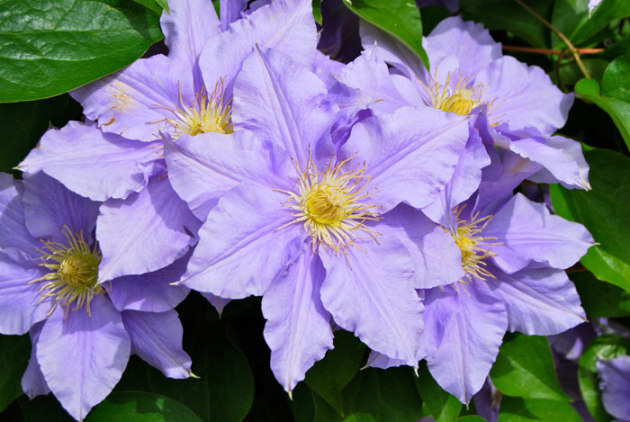
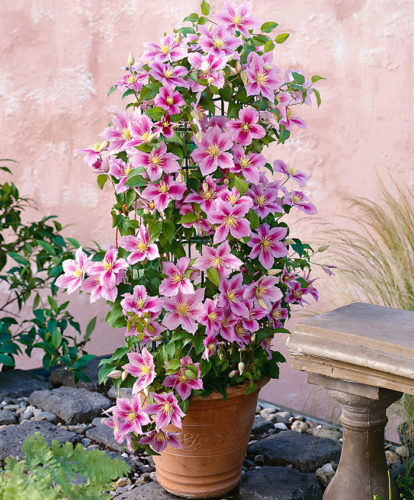
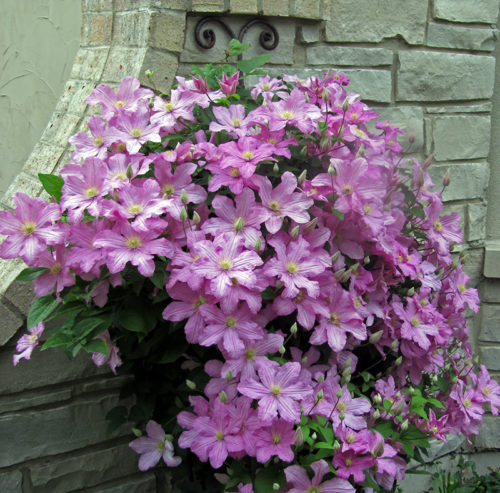



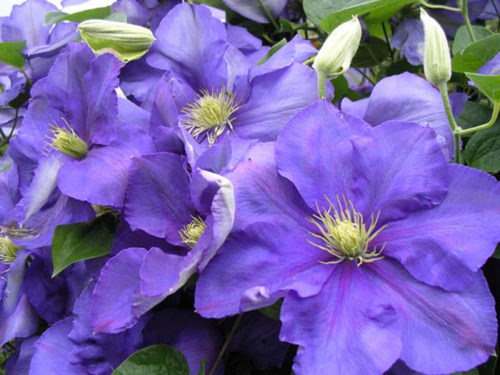

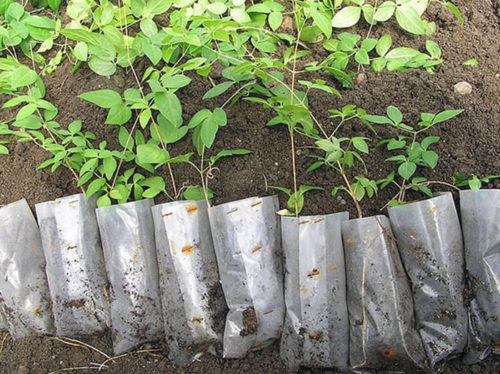

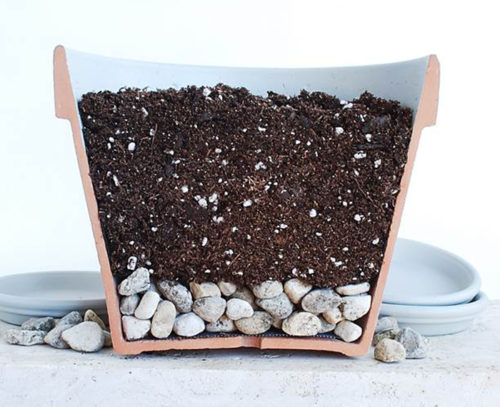


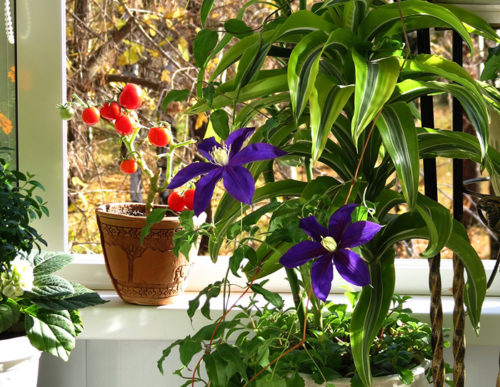
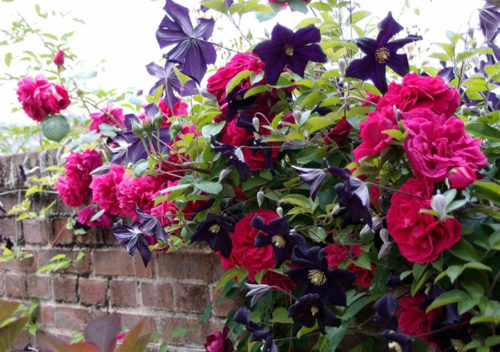

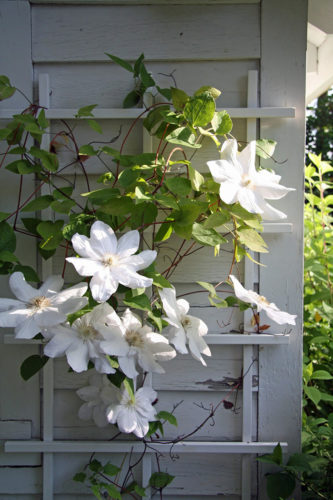














 Start a discussion ...
Start a discussion ...